David's Astronomy Pages
Notes - Session 628 (2018-09-09)
Notes
(S627)
Notes
Main
Home
Page
Notes
(S629)
David's Astronomy Pages
|
Notes (S627) |
Notes Main |
Home Page |
Notes (S629) |
| Session Aims & Highlights | |
|
- Observing Result - Night Summary Plot |
|
| Operational Issues | |
| - Critical Issues (0), Major Issues (0), Minor Issues (0), Continuous Improvement (0) | |
| Fully Automated Operation | |
| Sky Flats Routine | |
| Sky Flats Reduction | |
 |
Images from 2018-09-09 >> |
| 2018-09-12 (Session 629) | |
|---|---|
| Sky Flats Routine | |
Main aims
Equipment & Software
Highlights
Summary Plots & Logs
|
Observing Result (2018-09-09, S628) Operations started at 19:18, Sky Flats started at 19:27, with first useful Flats at 19:57 Sky Flats ended at 20:32, Automated Mode from 20:56, Job Queue started at 21:10, Session Suspended at 21:36 due to Cloud Manual Mode from 22:03, Session Ended/Observatory Closed at 22:05 |
 |
| (Observation Status : Green=Completed, Yellow= Partially Completed, Red= Failed) |
|
Night Sky Summary Plot -
2018-09-09 Top axis: Sky Brightness at Zenith (in ADU/s) Lefthand axis: Local Time (hh LT). Righthand axis: Sun Altitude (degs) |
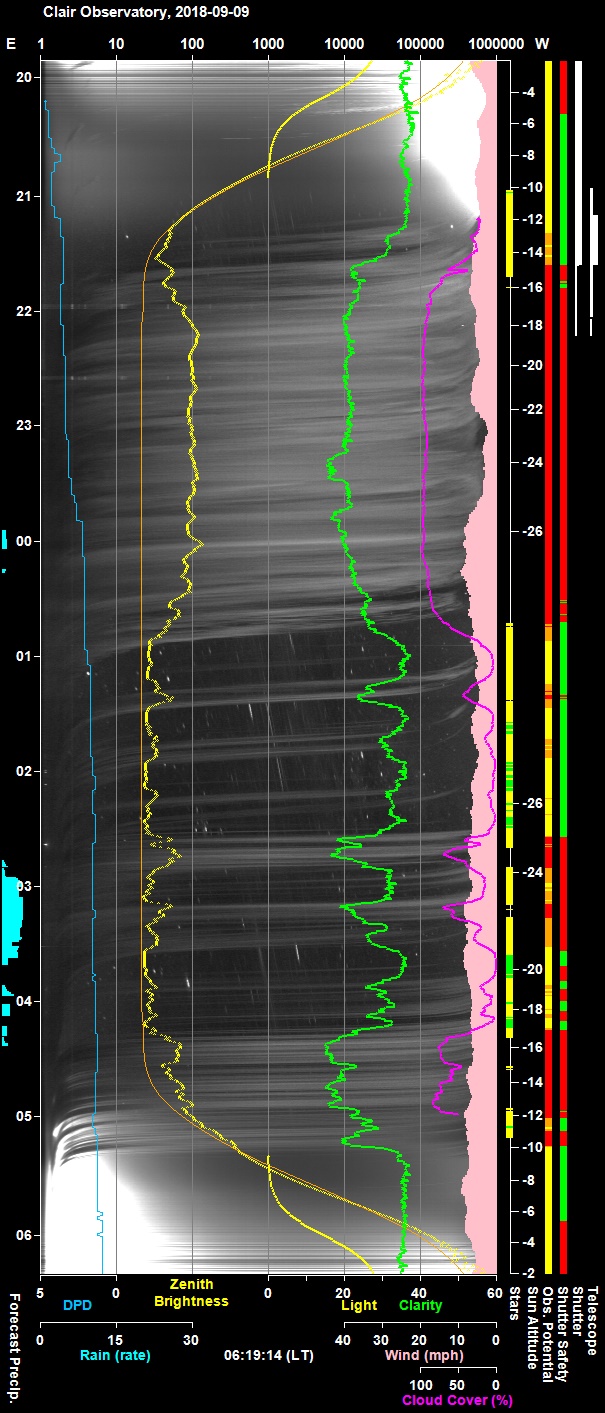 |
Back to Top
Back to Top
Fully Automated Operations covered the range of use and range of log reporting seen in recent sessions and are not documented here on this occasion.
Back to Top
The new Sky Flats routine was again tested this evening. Routine was started off early (Sun at +1.3 deg altitude). This was too early than needed and the skies for the first filter set (B, 2x2) weren't dark enough until Sun was at -2.5 deg altitude.
(Eventually the routine will be kicked off by the Observatory Manager itself at a more precisely defined sun altitude, but at this stage in its development it was again manually initiated and monitored).
4 sets were successfully acquired before the sky became too dark to take flats that would meet ADU target (30,000 +/- 5,000) within 10s exposure
Results
| Set |
Filter / Bin Set |
Sun Altitude (deg) |
Exposure (s) |
Av. Count (ADU) |
Target Count (ADU) |
Total Time (incl Slew) (mins) |
Result | |||||
| 1 | B, 2x2 | -2.67 to -3.13 | 1.04 to 1.57 | 29053 | 30000 | 4 mins | Successful Set | |||||
| 2 | B, 3x3 | -3.66 to -4.05 | 1.24 to 1.92 | 29203 | 30000 | 5 mins | Successful Set | |||||
| 3 | V, 2x2 | -4.21 to -4.84 | 4.02 to 8.24 | 28392 | 30000 | 6 mins | Successful Set | |||||
| 4 | V, 3x3 | -5.00 to -5.49 | 4.66 to 8.85 | 28637 | 30000 | 5 mins | Successful | |||||
| 5 | R, 2x2 | -5.62 | 10 | 13913 | 30000 | 1 min | Sky too dark | |||||
| 6 | R, 3x3 | -5.79 | 10 | 24611 | 30000 | 2 min | Sky too dark | |||||
| 7 | Xo, 2x2 | -5.92 | 10 | 21111 | 30000 | 1 min | Sky too dark | |||||
| 8 | Xo, 3x3 | -6.08 to -6.43 | 7.44 to 10.0 | 12701 to 64729 | 30000 | 3 min | Sky borderline | |||||
| 9 | S, 3x3 | -6.56 | 10 | 24953 | 30000 | 1 min | Sky too dark | |||||
| 10 | I, 2x2 | -6.69 | 10 | 2347 | 30000 | 1 min | Sky too dark | |||||
| 11 | I, 3x3 | -6.82 | 10 | 4384 | 30000 | 1 min | Sky too dark | |||||
| 12 | C, 1x1 | -6.95 | 10 | 2404 | 15000 | 2 min | Sky too dark | |||||
| 13 | C, 3x3 | -7.08 | 10 | 15962 | 30000 | 1 min | Sky too dark | |||||
( Xo is Exoplanet Filter (V+R), S is spectroscopic filter, Flats with Ha filter weren't attempted on this occasion, tests in the previous session showed that the sky had become too dark for a 10s exposure with the Ha filter at Sun Altitude of -2.9 deg)
Learning from the previous test frame weren't mechanically dithered in order to save time. However to still ensure stars don't get through to the final Master Flats, telescope tracking was turned off which produce a natural form of dithering. The star trails that are present in the images can be removedby Median Averaging during creation of the Master Flats.|
Single Sky Flat, B filter (3x3) (1.58s, #628024, sun alt -3.9 deg) |
Master Flat, B filter (3x3) (Average Median for 15 frames ) |
|
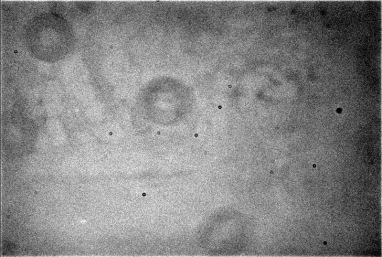 |
 |
|
|
Single Sky Flat, V filter (3x3) (4.66s, #628046, sun alt -5.0 deg) |
Master Flat, V filter (3x3) (Average Median for 15 frames ) |
|
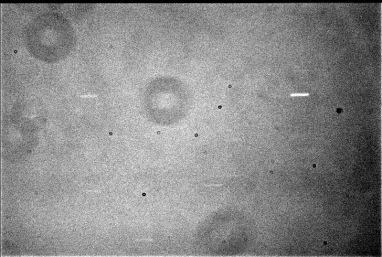 |
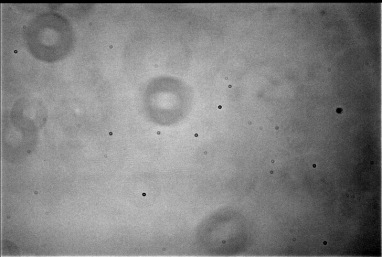 |
|
|
Single Sky Flat, Xo filter (3x3) (8.26s, #628064, sun alt -6.1 deg) |
Master Flat, Xo filter (3x3) (Average Median for 10 frames) Traces of stars are present (see discussion above) |
|
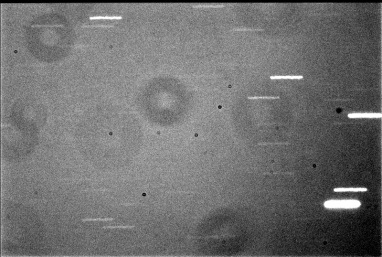 |
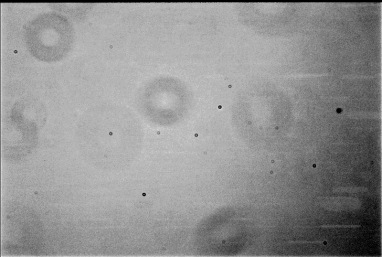 |
|
|
All Frames 50% original size (CCD Temp -15°C) |
||
Some strange results were obtained when take
flat set of Xo filter (3x3 binning). After starting the 3rd frame produced a
wildly unexpected ADU count of 64729, compared to only 28393 from the preceding
frame. It's exposure (8.26s) is correctly calculated, based on trying to meet
30,000 and using the count of 28393 ADU from the preceding 7.82s frame.
Because the frame has such a high ADU count the exposure of the 4th frame is cut
back to 3.82s, which turns out to dark, so the 5th frame is bumped back up to
8.77s and so on. The final two 10s frames appears to have normal ADU
counts again.
Take Trial Frame(s)..
Taking 1.00s Flat 20:23.. Ok SKY FLAT [1923.34 ] 3x3 1.00s Xo ( 4567 ADU, SunAlt -6.01°)
Taking 6.56s Flat 20:23.. Ok SKY FLAT [1923.45 ] 3x3 6.56s Xo (26448 ADU, SunAlt -6.04°)
Take Main Frame(s)..
Taking 7.44s Flat 1/15.. Ok SKY FLAT [00628062] 3x3 7.44s Xo (28517 ADU, SunAlt -6.08°)
Taking 7.82s Flat 2/15.. Ok SKY FLAT [00628063] 3x3 7.82s Xo (28393 ADU, SunAlt -6.11°)
Taking 8.26s Flat 3/15.. Ok SKY FLAT [00628064] 3x3 8.26s Xo (64729 ADU, SunAlt -6.14°)
Taking 3.82s Flat 4/15.. Ok SKY FLAT [00628065] 3x3 3.82s Xo (13063 ADU, SunAlt -6.21°)
Taking 8.77s Flat 5/15.. Ok SKY FLAT [00628066] 3x3 8.77s Xo (64728 ADU, SunAlt -6.24°)
Taking 4.06s Flat 6/15.. Ok SKY FLAT [00628067] 3x3 4.06s Xo (12701 ADU, SunAlt -6.27°)
Taking 9.58s Flat 7/15.. Ok SKY FLAT [00628068] 3x3 9.58s Xo (64729 ADU, SunAlt -6.30°)
Taking 4.44s Flat 8/15.. Ok SKY FLAT [00628069] 3x3 4.44s Xo (12595 ADU, SunAlt -6.33°)
Taking 10.00s Flat 9/15.. Ok SKY FLAT [00628070] 3x3 10.00s Xo (25558 ADU, SunAlt -6.37°)
Taking 10.00s Flat 10/15.. Ok SKY FLAT [00628071] 3x3 10.00s Xo (24179 ADU, SunAlt -6.43°)
Checking ADU Count... Fail Aborting (sky has become too dark for this Filter/Bin set)
Calculating and examining ADU Rates per second helps to see what is happening. Two initial trial frames and 7 of the main frames sit on one clear line where ADU rate is gradually falling as the sun gradually descends further below the horizon and the sky darkens. Three points are clearly sitting on a much high higher line. Are they recording passing bright cloud or flickering sun rays bouncing off high clouds, or is an anomaly of the camera or an anomaly in the measurement of image's ADU count.
| Anomalous ADU rates, Xo filter (3x3) |
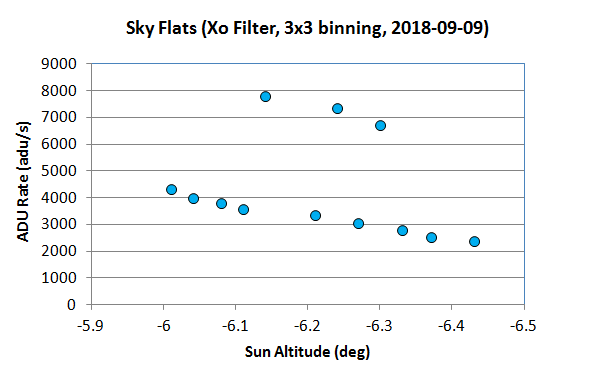 |
Examining individual frames reveals that the problem is the measurement of the images ADU count. The code has been setting image' contrast to use CCDSoft's Weak/Adaptive contrast setting and then taking the upper value of the range to use as the images ADU count for testing against Target ADU count and adjusting the following exposures. This is setting has worked well in the past for displaying Flat frames, and earlier sky flats, but in this case stars had already begun to appear and the presence of bright star was enough to completely through off the weak/adaptive setting.
Code will be updated to take ADU count as the peak value in the histogram,
found as the Image's background value after setting a Strong/Adaptive contrast
using the histogram plot. or by the following code :
Image.AutoContrast(cdAutoContrastSBIG,
cdBgStrong, cdHLAdaptive)
AduCount = Image.Background
So several useful lessons learnt from the test
a) shorter exposure trial (say 0.2s) could be used at the start to test for
limit over-saturation of the CCD
b)
allow a set to be started when trail image has fallen to below ADU count +
Tolerance
c) the method by which an image's representative ADU count is
measured is important. If its not consistent there is a risk the quality of the
dataset can be significantly reduced
d) again be less ambitious over the number of filter/bin flat
sets that can be done within the same evening.
e) dithering between frames
is shown to not be necessary, if telescope tracking is turned off (average
median stacking will work)
f) the optimal order of flats sets (by
filter/binning) is probably best established by measuring ADU collection rates
against the dusk sky, rather than guessing
Back to Top
Previously I’ve always acquired my flat frames with a constant exposure for a given filter/binning set. Reduction has then simply involved subtracting a Master Dark of the same temperature & exposure from the raw flat frames. A Master Bias frame is not required as the bias is already including in the Master Dark frame. This has been ok for a light panel flats , but less good for sky flats even when normalising frames before calculating the Median Average)
The new Sky Flats routine varies exposure time to maintain the ADU count of individual Frames close to a target count of 30,000 ADU. Image reduction for these flats is necessarily more involved, and requires the Scaling of the Master Dark to allow for difference in exposure times and inclusion of a Master Bias.
I'm use CCDSoft5's Image Reduction tool for all my Image Reduction.
For reducing my new Sky Flats and I will use a Master Bias, a Master Dark with
an exposure not less than my longest Flat frame exposure, and have “Automatic”
dark exposure correction turned on (so that the Master Dark will be scaled based
on the exposure of the each Flat frame).
However I was uncertain
whether CCDSoft5 would
a) automatically subtract the Bias
from the Dark Frame before the remaining Dark/Thermal Signal is scaled, or
b) not subtract Bias from the Dark Frame (requiring that I need to supply a
modified Master ‘Dark’
which
already has the Bias subtracted from it)
The answer is in fact a). (CCDSoft does subtract the Bias from
the Dark Frame before Scaling)
Test Method:
Using a quickly built routine where I could embed a
square patch of fixed user defined value into a FITs file, I prepared special MasterBias, MasterDark & Raw Flats for a test, and then run Image Reduction on
the Raw Flat compared results against would I would expect a) and b) to each
give
Files:
- Raw Flat (1.53s exposure), had an inserted test square
with value 28500 (picture attached)
- Master Dark (10s exposure) had an
inserted test square with value 3000
- Master Bias had an inserted test
square with value 1000
| Raw Flat with embedded square of fixed value (28500) |
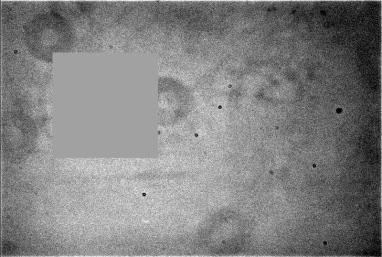 |
|
Modified Raw Flat Frame 1.53s exposure, 3x3, B Filter |
Predictions:
a) would predict reduced test square to have value 26347
= 28500 – 2000 - (3000-2000) * 1.53/10.0
(Bias subtracted automatically
from Dark)
b) would predict reduced test square to have value 26041
= 28500 – 2000 - (3000) * 1.53/10.0
(Bias not subtracted automatically from
Dark)
Result:
My resulting Reduced Flat had a test square with
value 26447
This points to a) being the method employed by CCDSoft5.
(i.e. Bias is subtracted from
the Dark Frame before Scaling)
The 100 ADU difference (26447-26347) is a fixed amount (a sort of pedestal)
that CCDSoft adds during the processing to handle any negative pixel results. I
had forgotten to include this when making my forecasts.
The result means
that I don’t need to create special Bias Subtracted versions of my Master Darks
and I can be confident in the reduction process that I will use for my AllSky
Flats.
Back to Top
The Sky Flats routine since was tested at dusk on 2018-09-12, following a number of fixes and improvements to the code since the last session. Routine was started off early (Sun at -1.2 deg altitude).
6 sets were successfully acquired before the sky became too dark to take flats that would meet ADU target (30,000 +/- 5,000) within 10s exposure. For the Clear (C) filter 25 frames were taken compared to standard 15 frames taken for other filters. This was to reflect that most pictures are taken with the C filter.
Results
| Set |
Filter / Bin Set |
Sun Altitude (deg) |
Exposure (s) |
Av. Count (ADU) |
Target Count (ADU) |
Total Time (incl Slew) (mins) |
Result | |||||
| 1 | Ha, 3x3 | -1.31 to -1.71 | 2.09 to 2.67 | 30203 | 30203 | 4.1 mins | Successful Set (15 frames) | |||||
| 2 | I, 2x2 | -2.52 to -2.92 | 1.00 to 1.26 | 30433 | 30000 | 9.1 mins | Successful Set (15 frames) | |||||
| 3 | I, 3x3 | -3.56 to -3.59 | 1.03 to 1.48 | 29910 | 30000 | 7.3 mins | Successful Set (15 frames) | |||||
| 4 | R, 2x2 | -4.06 to -4.52 | 2.41 to 3.99 | 29565 | 30000 | 4.9 mins | Successful Set (15 frames) | |||||
| 5 | R, 3x3 | -4.68 to -5.11 | 2.12 to 3.67 | 29393 | 30000 | 4.4 mins | Successful Set (15 frames) | |||||
| 6 | C, 3x3 | -5.25 to -5.90 | 1.40 to 3.18 | 29795 | 30000 | 6.2 mins | Successful Set (25 frames) | |||||
| 7 | C, 2x2 | -6.07 to -6.39 | 8.63 to 10.00 | 27792 | 30000 | 6 mins | Sky too dark after 6 frames |
No new lessons, but the following points relate to past lessons that haven't yet been implemented :
a) shorter exposure trial (say 0.2s) could be used at the start to test for
limit over-saturation of the CCD
b) the optimal order of flats sets (by
filter/binning) is probably best established by measuring ADU collection rates
against the dusk sky, rather than guessing
(Eventually the routine will be kicked off by the Observatory Manager itself at a more precisely defined sun altitude, but at this stage in its development it was again manually initiated and monitored).
Pictures showing the Master Flats generated from the new sky flats from Session S629_Flats.
|
Master Flat, Ha filter (3x3) (Average Median for 15 frames ) |
 |
|
Master Flat, I filter (3x3) (Average Median for 15 frames ) |
 |
|
Master Flat, R filter (3x3) (Average Median for 15 frames ) |
 |
|
Master Flat, C filter (3x3) (Average Median for 25 frames ) |
 |
|
All Frames 50% original size (CCD Temp -10°C) |
Back to Top
| This Web Page: | Notes - Session 628 (2018-09-09) |
| Last Updated : | 2023-11-26 |
| Site Owner : | David Richards |
| Home Page : | David's Astronomy Web Site |